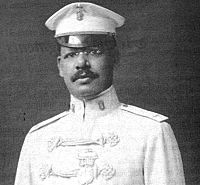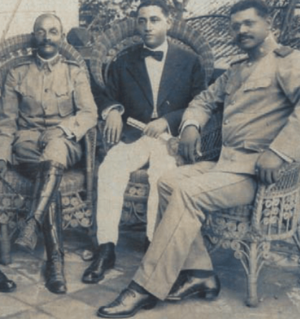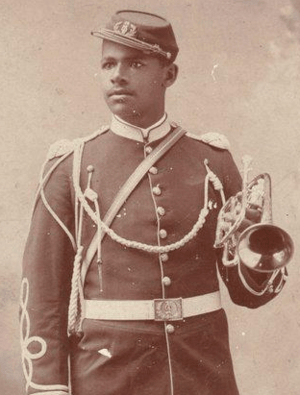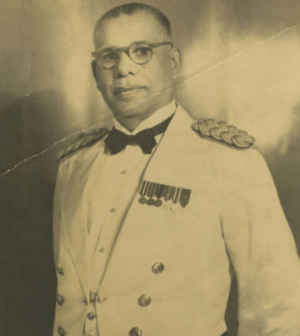Walter Loving facts for kids
Quick facts for kids
Walter Loving
|
|
|---|---|
 |
|
| Birth name | Walter Howard Loving |
| Born | December 17, 1872 Nelson County, Virginia, United States |
| Died | February–March 1945 (aged 72) Manila, Philippines |
| Allegiance | |
| Service/ |
United States Army Volunteer Army of the United States Philippine Constabulary Philippine Commonwealth Army |
| Rank | Major (Philippine Constabulary) Major (U.S. Army) Lieutenant Colonel (Philippine Commonwealth Army) |
| Unit | Philippine Constabulary Band Philippine Army Orchestra U.S. Army Military Intelligence Division |
| Awards | Presidential Merit Award Distinguished Conduct Star Philippine Campaign Medal |
Walter Howard Loving (born December 17, 1872 – died February/March 1945) was an African American soldier and talented musician. He is best known for leading the Philippine Constabulary Band. This band was very special because it was the first time a group other than the U.S. Marine Band played for a U.S. President's parade!
In 1909, Loving led his band in the parade for U.S. President William Howard Taft. It is also believed that Loving was the first African American to lead a musical performance at the White House. Besides his music career, Loving also worked for the U.S. Army's intelligence team during World War I. He also invested in real estate in San Francisco Bay when he was not in the military.
Later in his life, Loving returned to the Philippines. He died in 1945 during the Battle of Manila. After his death, he received the Philippines' Presidential Merit Award.
Contents
Walter Loving's Early Life and Education
Walter Loving was born in 1872 near Lovingston, Virginia. His father had been a slave. Walter grew up with his parents and many other family members.
When he was ten, Loving moved to Minnesota. He lived with the family of Charles Eugene Flandrau, who employed Loving's sister, Julia. Later, Walter and Julia moved with the Flandrau family to South Dakota. There's a family story that says Theodore Roosevelt, who later became president, taught Loving math in 1886.
Loving's biographer, Robert Yoder, thinks that Flandrau might have been like a father to Walter. We know that Loving went to elementary school with Flandrau's son. It is also believed that Flandrau helped pay for Loving's education at the Preparatory High School for Negro Youth in Washington, DC. He also studied at the New England Conservatory of Music.
As a young adult, Loving joined the U.S. Army several times as a musician. He later became a bandleader. He left the New England Conservatory of Music to rejoin the Army. His teachers thought he was a very talented cornet player and did not want him to leave. After leaving the conservatory, Loving became the leader of the band for the 45th United States Volunteer Infantry Regiment.
Walter Loving's Military Music Career
Leading the Philippine Constabulary Band
In 1902, Walter Loving was chosen to create the Philippine Constabulary Band. This happened because Governor-General of the Philippines William Howard Taft had heard Loving's band play before. Loving quickly connected with his new band members because he had learned both Spanish and Tagalog during an earlier visit to the Philippines.
Under Loving's leadership, the Philippine Constabulary Band became very famous for its amazing music. They were known in both the Philippines and the United States.
- In 1904, the band played at the Louisiana Purchase Exposition in St. Louis. They won First Prize against other top military bands.
- The Army and Navy Life magazine called them "one of the finest of all military bands in the world."
- The Pacific Coast Musical Review said the band was "in a class by itself."
In 1915, the famous bandleader John Philip Sousa was invited to conduct the band in San Francisco, California. He later said, "when I closed my eyes, I thought it was the United States Marine Band."

The Philippine Constabulary Band was the main band in the 1909 U.S. presidential inaugural parade. This parade was for William Howard Taft, who had helped Loving start the band. It was the first time a band other than the United States Marine Band led the parade for the President of the United States.
The day after the parade, the band was invited to play for President and Mrs. Taft at the White House. This was the first time a band from outside the continental United States performed at a White House event. It is also believed that this was the first time an African American person conducted a musical performance at the White House.
Loving continued to lead the band until 1915. He had to take a break because he became sick with tuberculosis.
Working in Military Intelligence
During World War I, Loving served in the U.S. Army's Military Intelligence Division. He was a major during the war. One of his first jobs was to investigate African American leaders who were thought to be causing trouble. He would go to meetings in regular clothes and find people who could give him information.
Later, Loving traveled around the United States to check on how African American soldiers were being treated in Army camps. He wrote a report saying that black soldiers were treated best when their white officers were from the western United States and northeastern United States. He suggested that white officers from the southern United States should not lead units with black soldiers.
Loving also spoke out against the Army's rules about non-commissioned officers (NCOs). He pointed out that:
"The Army started assigning white NCOs to black units, which was new. Even during the Civil War, black units had black NCOs... Most of these white NCOs acted like old-time overseers, even carrying guns when they took groups of men out to work."
Return to Manila and Later Career
After World War I, Loving went back to the Philippines. He led the Philippine Constabulary Band again for three years. Then he retired a second time and moved to Oakland, California with his wife, Edith. In Oakland, Loving did well by investing in real estate.
From 1937 to 1940, Loving again took charge of the Philippine Constabulary Band. By then, it was called the Philippine Army Orchestra. He returned to the Philippines because Manuel Quezon, the President of the Philippines, personally invited him. Loving was made a lieutenant-colonel in the Philippine Commonwealth Army. He also became a "Special Advisor to the President of the Philippines." He retired in 1940 but continued to live in Manila.
Walter Loving's Death
In 1941, Walter and Edith Loving were captured by Japanese forces after Manila surrendered. While he was held captive, Loving wrote a song called Beloved Philippines to inspire resistance. He was released in 1943 because he was getting older and his health was failing.
In 1945, during the Battle of Manila, Loving was arrested again. He was held with other Americans and Filipinos at the Manila Hotel.
The exact details of Loving's death are not fully clear. One story says that as American and Filipino armies were winning, the Japanese soldiers ordered the prisoners to run to the beach while they shot at them. Loving, who was 72, refused to run. He said, "I am an American. If I must die, I'll die like an American." Then he was killed.
Another story says that the prisoners at the Manila Hotel tried to escape. Loving used his body to block a staircase, stopping Japanese troops from chasing them. He was then killed. A third account from 1945 says that retreating Japanese troops shot Loving in the back. Wounded, he crawled from the Manila Hotel to the bandstand at Luneta Park, where his band had often performed, and died there.
In 1952, Loving was given the Presidential Merit Medal by the Government of the Philippines. This happened at a ceremony in Luneta Park, where his last song, Beloved Philippines, was played. Loving also received the Distinguished Conduct Star, which is the second-highest military honor in the Philippines. He also got the United States' Philippine Campaign Medal for his service during the Philippine–American War.
Walter Loving's Personal Life
Loving married his wife, Edith, in 1916. They had one son, also named Walter. Walter Loving Jr.'s godfather was Roscoe Simmons, a longtime friend of Loving.
Loving was interested in politics throughout his life. He supported both Republican and Democratic candidates. In 1916, Loving asked his former supporter, Taft, to introduce him to Republican presidential candidate Charles Evans Hughes. Loving wanted to help with Hughes's campaign. However, Taft said no, explaining it wasn't right for him to make such an introduction. Taft also told Loving he was sad that Loving was no longer leading the Constabulary Band, which Loving had largely created. Loving also campaigned for Isabella Selmes Greenway in 1932. She was Charles Flandrau's granddaughter and was running for Congress in Arizona.
Images for kids



